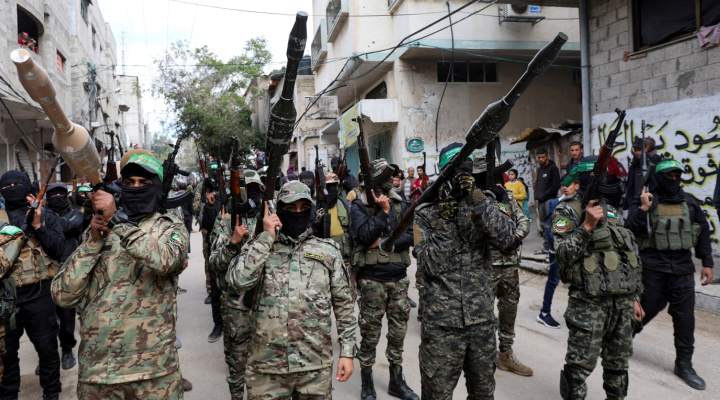Hamas terrorists carry grenade launchers at the funeral of Marwan Issa, a senior Hamas deputy military commander who was killed in an Israeli airstrike during the conflict between Israel and Hamas, amid a ceasefire between Israel and Hamas, in the central Gaza Strip, Feb. 7, 2025. Photo: REUTERS/Ramadan Abed
You’ve probably seen it before, not just in Gaza, not just in this war, but in war zones around the world. Amid the twisted metal and shattered concrete, there it is: a teddy bear. Soft, childlike, absurdly out of place. The implication is immediate and visceral. An innocent child has died here. The toy, half-buried in dust, is all that remains. It’s an image designed to evoke grief, outrage, and blame.
The grim truth is that war is horrific, and the innocent often suffer most. The death of a child is always a tragedy, whether in Gaza, in Israel, or anywhere else.
But in Gaza, as HonestReporting has documented repeatedly, Hamas not only puts civilians, including children, in harm’s way, it also manipulates the narrative. It inflates the civilian death toll, especially that of women and children, as part of a broader propaganda war against Israel.
And it works. The media has helped enable this strategy, often by repeating Hamas-supplied data without question, or worse, by using imagery that advances a one-sided emotional message. One of the most familiar examples is the teddy bear in the rubble.
These images tend to surface soon after Israeli airstrikes and spread quickly across international news outlets and social media. The message is unmistakable: a child was killed here. No caption is necessary. The toy says it all.
One example appeared in a BBC report on a blast at a Gaza café, where a senior Hamas terrorist was targeted. Amid the destruction, a teddy bear, barely damaged except for some dust, sat upright and prominently placed in the wreckage. The implication was clear. But are images like this always as genuine as they seem?
A review of the Getty Images archives, which supplies photographs to the world’s major news outlets, raises doubts. In several cases, teddy bears seem to have been deliberately placed.
On January 21, 2025, as residents returned to their homes in Rafah during a ceasefire, two different photographers captured images of children pulling a red teddy bear from the rubble. The captions described them as rescuing possessions. Yet the same bear appears in multiple shots, handled by different children, raising questions about how the scene was presented.




This is not an isolated case. A photo taken on October 6, 2024, by Abed Rahim Khatib for Turkish agency Anadolu, shows teddy bears placed atop rubble in Khan Yunis. The caption describes widespread devastation caused by Israeli strikes.

The same bear, in a nearly identical setup, appeared again in another Getty image, dated December 1, 2024. This photo, credited to Saeed Jaras of Middle East Images, was posted alongside the caption, “The girl who gathered them attempts to preserve joy amid the devastation.”

A broader search of Getty’s Gaza archive shows similar images again and again. The bears are often clean, carefully positioned, and stand out starkly against the grey rubble around them.
None of this is to suggest that children are not victims of war. They are. Civilian deaths occur even when precautions are taken. But the repeated appearance of carefully placed toys should raise questions. Not about whether tragedy exists, but about how it is presented and by whom.




A picture is worth a thousand words. And the cumulative effect of these carefully curated images is to build a false narrative — one in which Israel is cast as reckless or cruel, while Hamas’ tactics and responsibility are overlooked.
That narrative has taken hold. Headlines like The New Yorker’s recent “The War on Gaza’s Children” show how powerful these images can be. They drown out facts, fuel outrage, and make it harder to speak honestly about what is really happening.
No, @NewYorker, this is not a “war on Gaza’s children.”
It’s a war on Hamas, the terrorist organization responsible for bringing catastrophe upon everyone in Gaza. pic.twitter.com/wobsds5XjJ
— HonestReporting (@HonestReporting) July 8, 2025
Because sometimes, a teddy bear on a pile of rubble is more persuasive than the truth.
The author is a contributor to HonestReporting, a Jerusalem-based media watchdog with a focus on antisemitism and anti-Israel bias — where a version of this article first appeared.
The post A Teddy Bear in the Rubble: Are Gaza War Images Manipulated to Harm Israel? first appeared on Algemeiner.com.
Click this link for the original source of this article.
Author: Rachel O’Donoghue
This content is courtesy of, and owned and copyrighted by, https://www.algemeiner.com and its author. This content is made available by use of the public RSS feed offered by the host site and is used for educational purposes only. If you are the author or represent the host site and would like this content removed now and in the future, please contact USSANews.com using the email address in the Contact page found in the website menu.








